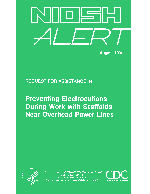Preventing Electrocutions During Work with Scaffolds Near Overhead Power Lines
August 1991
DHHS (NIOSH) Publication Number 91-110

WARNING! Workers may be electrocuted when erecting, moving, or working from metal or conductive scaffolds near overhead power lines.
The National Institute for Occupational Safety and Health (NIOSH) requests assistance in preventing electrocutions of workers who contact overhead power lines when erecting or moving scaffolds, or when using conductive tools or materials from scaffolds. Recent NIOSH investigations conducted under the Fatal Accident Circumstances and Epidemiology (FACE) Program suggest that many employers, contractors, and workers may be unaware of the hazards of working with scaffolds near uninsulated overhead power lines.
This Alert describes 13 deaths that occurred in six separate incidents when workers erected or moved scaffolds that came into contact with energized, overhead power lines, or when they contacted overhead power lines while using conductive tools or materials from scaffolds. To prevent such electrocutions, the recommendations in this Alert should be followed by every employer, manager, supervisor, and worker where scaffolds and conductive tools or materials are used near overhead power lines. Editors of appropriate trade journals, safety and health officials, and other persons (especially those in the building trades) are requested to bring this Alert to the attention of employers, contractors, and workers.
Preventing Electrocutions During Work with Scaffolds Near Overhead Power Lines
